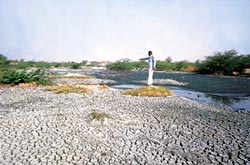Down the drain
 Located 70 kilometres southeast of Jodhpur, Rajasthan, Pali is home to one of the biggest cotton and synthetic textile dyeing and printing industries in the country. With more than 1,000 registered and unregistered textile processing industries, Pali generates effluents to the tune of about 35 million litres per day (mld).
Located 70 kilometres southeast of Jodhpur, Rajasthan, Pali is home to one of the biggest cotton and synthetic textile dyeing and printing industries in the country. With more than 1,000 registered and unregistered textile processing industries, Pali generates effluents to the tune of about 35 million litres per day (mld).
Pali today has three CETPs. But, as most people say, they are white elephants. The first one came up in 1983. When a feasibility study for the next two CETPs was carried out, the effluents from the dyeing industry were alkaline in nature. This was due to the use of sodium containing mainly alkaline chemicals. "We had to buy as much as five tonnes of sulphuric acid to neutralise our alkaline effluents," informs M L Gandhi, a local industrialist and member of trust that runs the CETPs. This was because industries in Pali were of hand-processing type, where all the work from dyeing to printing was carried out manually.
The National Environment Engineering Research Institute (NEERI), Nagpur, which surveyed Pali in mid-1990s, had suggested that if a few industries change their operations to power processing type, the problem of alkaline effluents would be overcome. This is because in power processing, the effluents are acidic in nature because of the use of sulphuric acid in certain processes. So by mixing the acidic effluents with alkaline, the problem could be solved and treatment through a CETP would be much easier.
With changes in the market demand and in economic policies like the increasing the price of pure cotton fabric, many industrialists shifted to power processing as it involved processing of synthetic fabric which was in high demand. And the effluents from the industry turned predominantly acidic. "Seventy per cent of the effluents from power processing is acidic because of the use of concentrated sulphuric acid," says Ashok Kumar, regional officer (Jodhpur), Rajasthan State Pollution Control Board.
The CETPs, which had been constructed to handle only alkaline effluents, have now become redundant and all the effluents are still going untreated into the Bandi river. "It is impossible to treat the acidic effluents till the time we can make massive in-plant changes," admits Jagat Singh, a chemist at the CETP. "We cannot release highly acidic effluents into the drainage system for the city. It has already destroyed many parts of the drainage system," says A R Khan, Pali's district collector.
Moreover, industries located on the riverbank have developed an interesting modus operandi to discharge the acidic effluents. These industries have constructed long underground pipes that end up in the Bandi river bed. Today, Pali's pollution woes have, in fact, worsened. Even after setting up three CETPs with an investment of about Rs 10 crore.
Related Content
- Order of the Supreme Court regarding untapped drains in Agra, Uttar Pradesh, 01/05/2025
- Judgment of the National Green Tribunal regarding pollution of river Yamuna at Agra and Mathura-Vrindavan due to discharge of untreated sewage in the river, 24/04/2024
- Order of the National Green Tribunal regarding pollution of Pawana river, Pune, Maharashtra, 05/04/2024
- Notes of argument submitted by Lalitkumar N. Chaudhari regarding dumping of MSW in Dhadi river, Jalgaon district, Maharashtra, 26/04/2023
- Joint committee report on the remedial measures taken by IRCON to contain the damage caused during the excavation of tunnel (T-77D), village Channar, Bankoot, district Rambar, Jammu & Kashmir, 17/04/2023
- Order of the National Green Tribunal on Adi Ganga, Kolkata, West Bengal, 23/11/2022
